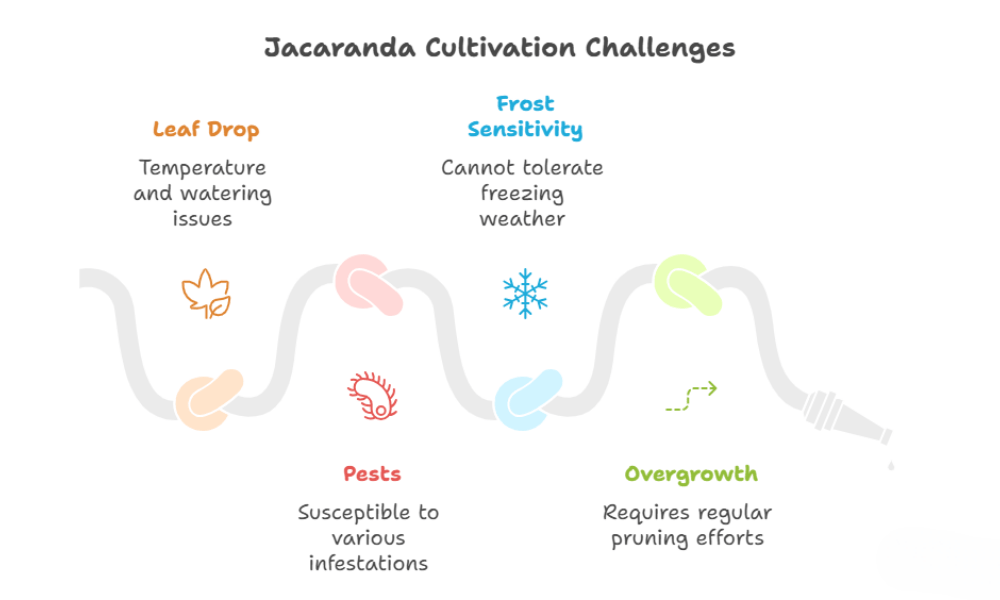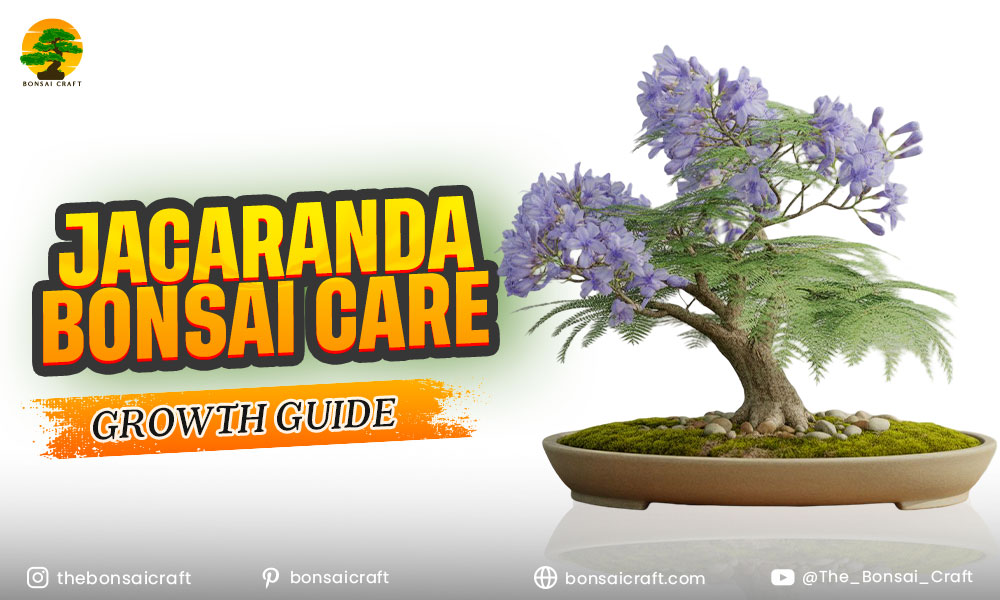
The jacaranda bonsai is one of the most breathtaking miniature trees you can grow. Known for its striking lavender-blue flowers and delicate fern-like foliage, the bonsai blue jacaranda tree captures the beauty of full-sized jacaranda trees in a compact form. Whether you are just beginning your bonsai journey or you’re an experienced grower, cultivating a jacaranda tree bonsai is a rewarding practice that combines art, patience, and horticultural skill.
As someone who has studied and practiced bonsai for years, I can confirm that caring for a bonsai jacaranda requires a balance of horticultural knowledge and creative design. This guide will walk you through everything from how to grow jacaranda bonsai from seed, pruning and training techniques, and the best care practices that ensure your miniature tree thrives for decades.
By the end, you’ll have a complete, timeless reference for nurturing your jacaranda tree in bonsai trees, whether your goal is vibrant blooms, a refined trunk structure, or simply enjoying the meditative process of bonsai care.
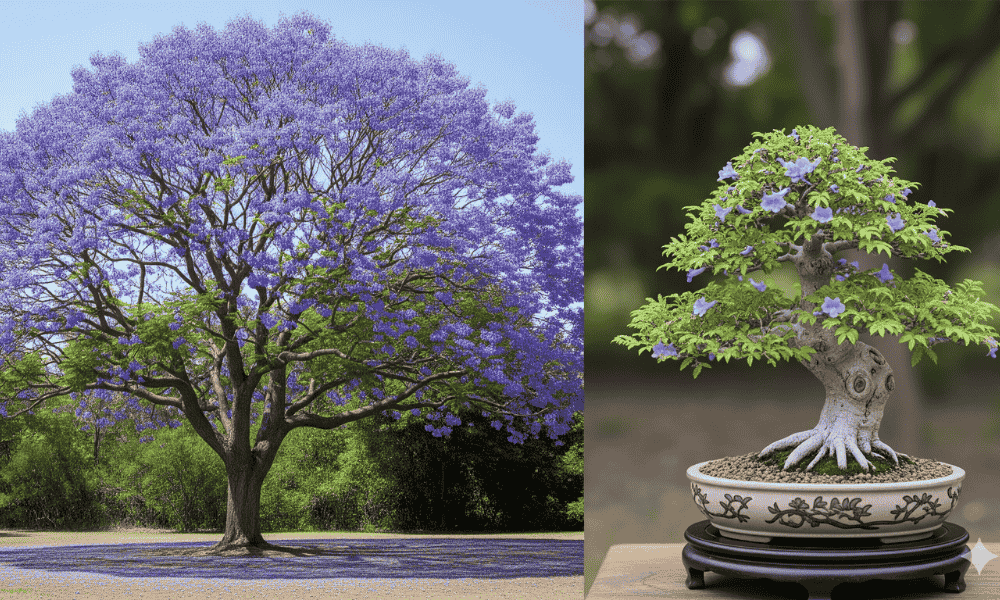
What Makes a Jacaranda Bonsai Unique?
The jacaranda bonsai stands out because of its soft, feathery leaves and vibrant flowers. Unlike many traditional bonsai species, jacarandas are subtropical trees, meaning they thrive in warm climates and require specific care conditions.
- Appearance: Fern-like foliage, smooth bark, and purple-blue blossoms.
- Growth habit: Fast-growing when young, adaptable to shaping.
- Symbolism: Associated with wisdom, creativity, and renewal.
Growing a bonsai jacaranda allows you to enjoy these qualities in miniature form while developing horticultural skills that last a lifetime.
How Long Does It Take to Grow a Jacaranda Bonsai?
A jacaranda bonsai usually takes 7–10 years to develop into a refined bonsai tree from seed. With proper pruning, wiring, and care, you may start shaping it within the first 2–3 years, though full maturity and flower production take longer.
The timeline for growing a jacaranda tree bonsai depends on:
- Starting point – Growing from seed takes longer than starting with a nursery sapling.
- Climate – Warm conditions accelerate growth, while cooler regions slow it down.
- Care routine – Consistent pruning, wiring, and soil management influence how quickly the bonsai takes shape.
Patience is essential, as bonsai artistry is about progress over years, not months.
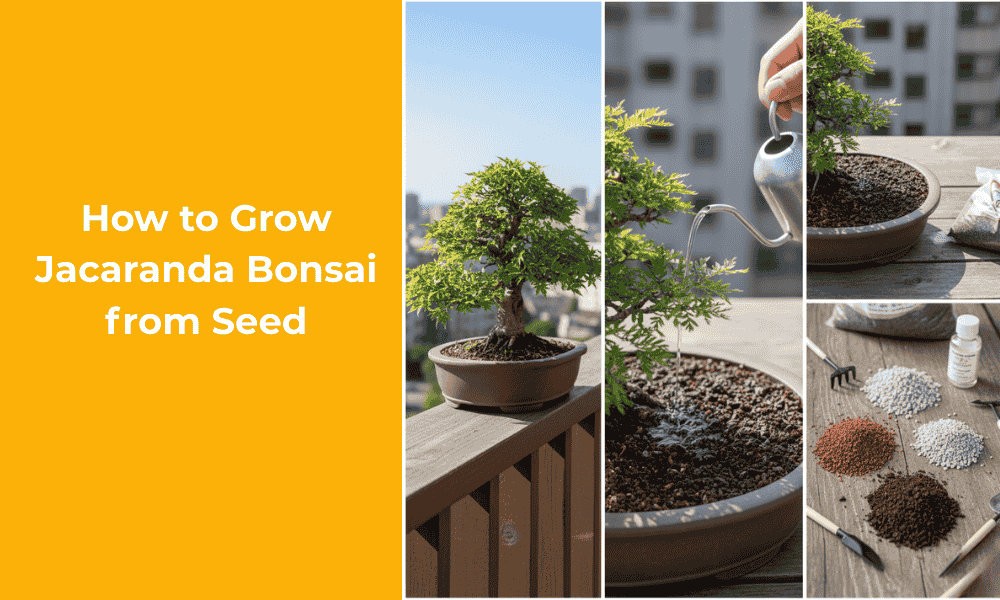
How to Grow Jacaranda Bonsai from Seed
To grow a jacaranda bonsai from seed, collect fresh seeds, soak them in water for 24 hours, and plant them in well-draining soil. Keep the soil moist and provide warmth and sunlight until seedlings emerge. Once saplings are strong, transfer them to bonsai pots for shaping.
Step-by-Step Guide
- Seed Preparation: Soak seeds overnight to soften the outer shell.
- Planting Medium: Use a mix of akadama, pumice, and organic potting soil.
- Germination Conditions: Place in a warm, bright area; maintain consistent moisture.
- Transplanting: Once seedlings reach 4–6 inches, carefully move them into training pots.
- Early Training: Begin gentle wiring after the first year to guide trunk movement.
Starting from seed allows you full control over shaping, making it ideal for patient bonsai enthusiasts.
How to Grow Jacaranda Bonsai (General Care Guide)
Growing a bonsai jacaranda requires sunlight, regular watering, pruning, and seasonal repotting. Use well-draining soil, fertilize during active growth, and protect the tree from frost. With proper care, your jacaranda tree bonsai will thrive and eventually bloom.
Essential Care Principles
- Light: Needs at least 6 hours of direct sunlight daily.
- Watering: Keep soil consistently moist but not waterlogged.
- Soil: Use a fast-draining mix to prevent root rot.
- Fertilization: Apply a balanced liquid fertilizer every 2 weeks in spring and summer.
- Temperature: Ideal range is 60–85°F (15–29°C). Protect from frost.
- Repotting: Every 2–3 years during early spring to refresh soil and prune roots.
How to Prune Jacaranda Bonsai
To prune a jacaranda bonsai, trim back new shoots after they produce 4–5 leaves, leaving 1–2 pairs. Remove weak or crossing branches, and shape the canopy to encourage a balanced, airy design. Pruning keeps your bonsai compact and promotes flowering.
Pruning Techniques
- Maintenance Pruning: Regularly trim soft new growth to control size.
- Structural Pruning: In early spring, cut back larger branches to refine the shape.
- Flowering Management: Prune lightly after flowering to encourage the next bloom cycle.
- Tools: Use sharp bonsai scissors or shears to avoid tearing delicate branches.
How to Train Jacaranda to Bonsai Tree
Training a jacaranda to bonsai tree involves wiring young branches, selective pruning, and shaping the trunk gradually. Start when the tree is young, applying gentle bends and adjustments over time to avoid breakage.
Training Methods
- Wiring: Use aluminum wire to bend young branches into desired positions.
- Trunk Development: Allow some branches to grow longer to thicken the trunk, then cut back.
- Styling Forms: Jacarandas adapt well to informal upright, broom, and slanting styles.
- Patience: Training should be gradual, respecting the tree’s natural growth patterns.
- Leaf Drop: Can occur in cooler weather or if watering is inconsistent.
- Pests: Watch for aphids, spider mites, and scale insects.
- Frost Sensitivity: Must be protected from freezing temperatures.
- Overgrowth: Jacarandas grow quickly; consistent pruning is essential.
Solution: Maintain a routine of monitoring, pruning, and adjusting care based on seasonal changes.
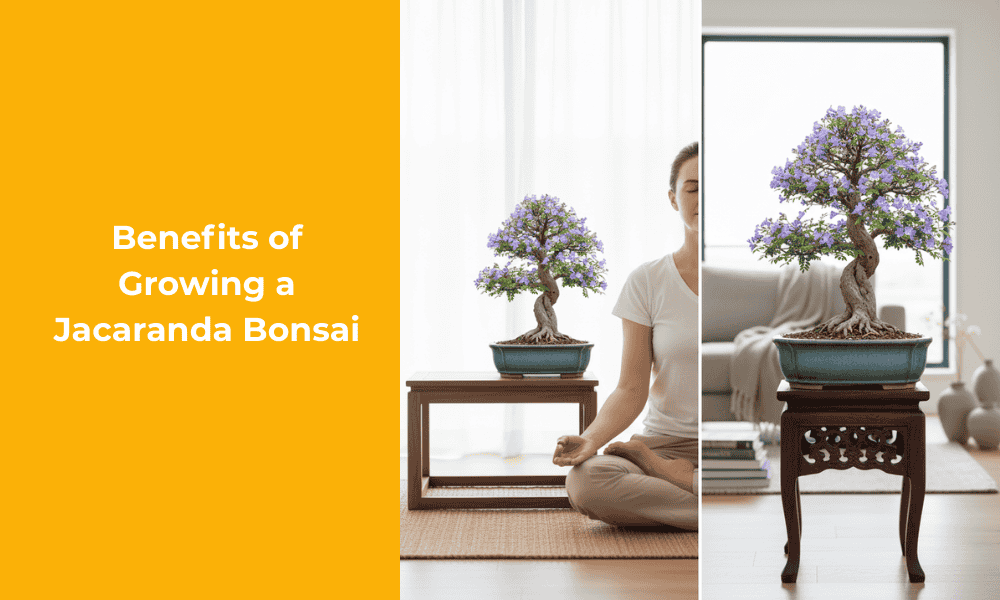
Benefits of Growing a Jacaranda Bonsai
- Enhances mindfulness and stress relief.
- Adds aesthetic beauty with unique purple blooms.
- Develops horticultural skills like pruning, wiring, and soil care.
- Offers a long-term, rewarding gardening project.
Growing a bonsai jacaranda is more than cultivating a plant—it’s creating a living piece of art that evolves with time.
Conclusion
Caring for a jacaranda bonsai is a journey of patience, artistry, and dedication. From how to grow jacaranda bonsai from seed to pruning and training, every step deepens your connection with this unique species. The bonsai blue jacaranda tree offers not only beauty but also the satisfaction of creating something enduring and meaningful.
As an expert tip: always observe your tree closely—each season reveals what it needs, and learning to respond builds true mastery. By following timeless care practices, your jacaranda tree bonsai can thrive for decades, becoming both a conversation piece and a source of personal joy.
FAQs
Can you bonsai a jacaranda tree?
Yes, you can bonsai a jacaranda tree. The jacaranda bonsai adapts well to container growth, responds to pruning and wiring, and rewards growers with stunning blue flowers and delicate foliage.
How long does it take to grow a jacaranda bonsai?
It typically takes 7–10 years for a jacaranda tree bonsai to mature, though shaping and early training can begin within 2–3 years. Patience and consistent care are essential for refinement.
What soil is best for jacaranda bonsai?
The best soil mix for bonsai jacaranda is well-draining, combining akadama, pumice, and organic compost. This prevents waterlogging and supports strong root development.
How do you prune a jacaranda bonsai?
To prune a jacaranda tree bonsai, cut back shoots after 4–5 leaves have grown, leaving 1–2 pairs. Remove weak, damaged, or crossing branches to maintain shape and health.
Can jacaranda bonsai trees flower indoors?
Yes, but flowering indoors requires plenty of sunlight—at least 6 hours daily. Supplement with grow lights if necessary to encourage blooms in your bonsai blue jacaranda tree.

